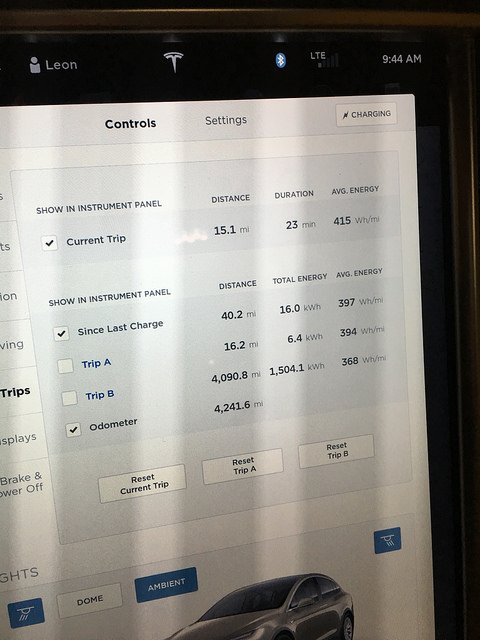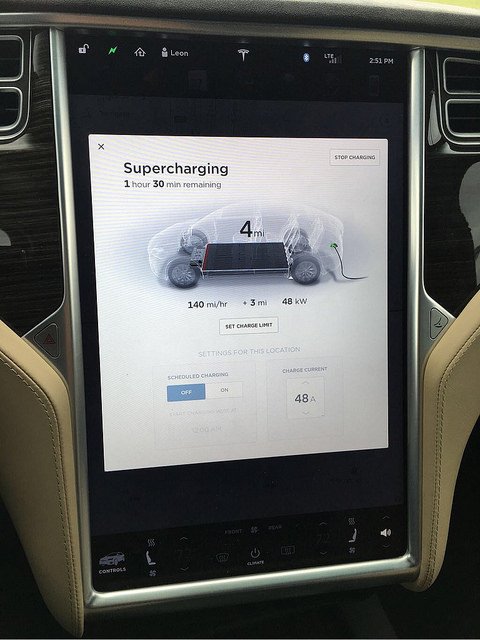Real Life Range of a 2016 Tesla Model X 75D
By Leon Fu
November 29, 2016
The first question I get is how far can it go on a charge and how fast does it take the recharge.
Charging Speed
Charging speed is limited to 15-25 miles/hour of charge on 220/240V AC, usually limited by the power coming out of the outlet. On AC power, the maximum charge is limited by the onboard AC/DC converted which maxes out at 10-11 kW. DC power goes much faster. The CHAdeMO are much faster and can push 40-50 kW of power using a special $450 adapter. These chargers can charge at a rate of 130-150 mph and can fully charge an empty Tesla in ~1.5 hours. The Tesla supercharger network is much faster at 80-120 kW and can charge at over 250 mph. However, the battery can only take this rate of charge when its near empty. It drastically slows down for the last 20% of charge. From 0 to 50% charge takes ~30 minutes. The next 50% takes ~1 hour, with the last 20% taking 45 minutes.
Range
How much range any electric car can travel is highly dependent on the driving situation. However, I've already racked up over 4000 miles on my Model X, and the car tells me how much energy I've used:

My trip meter shows that for the 4000 miles I've driven, I've used approximately 1500 kWh, for a real world average energy usage of ~370 Wh/mi driven. This is how I would drive an ordinary gasoline car, at highway speeds, with climate control, in typical Texas weather in the summer/fall.
The 75 kWh battery has ~65 kWh of useable energy. At 370 Wh/mi that gives us a range of 65,000 Wh / 370 Wh/mi = ~175 miles. That is real world driving. I can say driving 175 miles, the battery meter will read 0 miles. One of my Turo renters did drive ~15 miles past zero and had to get towed, so I'd say the battery is indeed a 75 kWh battery. I can certainly squeeze out more than 175 miles, but I would need to take conscious steps such as slowing down to below the speed limit, turning of climate control, gently. Tesla claims 237 miles on a charge, which is possible, but driving very conservatively, at 75F, with no climate control.
Thoughts on Range and 90 and 100 kWh battery.
Using ~370 Wh/mi, getting the larger 90 or 100 kWh battery, I'd expect an additional 40 and 67 miles respectively. The 90 kWh battery costs ~$10K more, while the 100 kWh battery is only included with a performance package costing $50K more. Is the additional range worth the money? In my opinion, usually not, unless you go on long road trips in remote areas frequently. An additional 40 or 60 miles doesn't really you to go anywhere that the 75 kWh battery couldn't go.
Most of the time when I have these situations:

The problem wasn't because I didn't have the larger battery. It was because the charging station didn't charge my battery fast enough. A larger battery wouldn't have helped me. In this particular case, I was charging over night at my friend's house in north Dallas, and he only had a 110V plug in his garage. The Model X only gets ~3.5 miles/hour regardless of whether it is a 75, 90, or 100 kWh battery. I would've been in the same situation even with the larger battery.
Supercharger Network
With a real world range of less than 200 miles to the low 200's. Tesla needs to space their superchargers 90 - 120 miles apart. Range anxiety starts to kick in at under 50 miles, as it means you might not get to where you need to go to recharge.
Compared with gas cars.
Gas cars today are so efficient that many easily go over 400 miles on a tank of gas. My mom's 2013 Hyundai Sonata goes well over 400 miles on a tank of gas and it isn't a leader in its segment. On the other hand, it also doesn't have anywhere close to the performance (sports/super car level) of Tesla's. If Tesla's were engineered for efficiency, I believe the range would be much closer. But Tesla wanted to dispel the myth that electric cars were slow, which they did, but at the expense of range. On the other hand, high performance gas cars don't have a 400 mile range either, but they also don't need hours to refuel.
Along the supercharger network, the travel experience is pretty close to a gas car as the charging stations are located in shopping centers and other attractions. But on my recent trip to West Texas, and other remote locations such as the mountains of Colorado, the charging infrastructure isn't here yet. The electricity is there, as there are more places where electricity is available than gasoline. But the high powered circuits needed to recharge EV's in a reasonable amount of time isn't quite everywhere yet. This will change as EV's become more popular, but as early adopters, we still need to look for places to charge.
Congratulations @leon-fu! You received a personal award!
You can view your badges on your Steem Board and compare to others on the Steem Ranking
Vote for @Steemitboard as a witness to get one more award and increased upvotes!